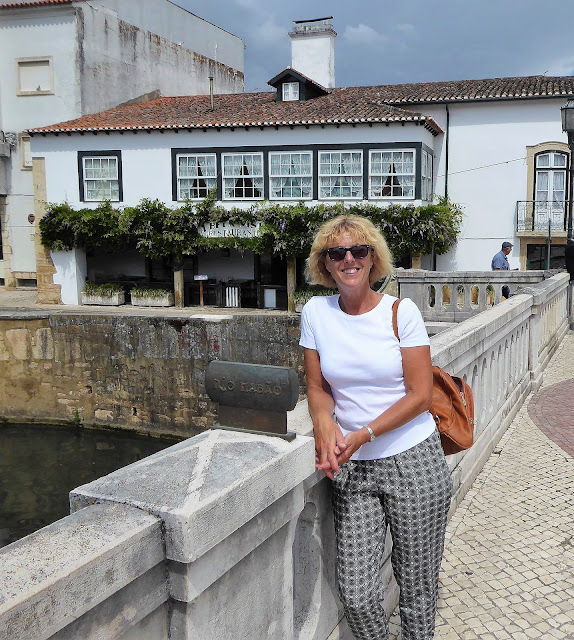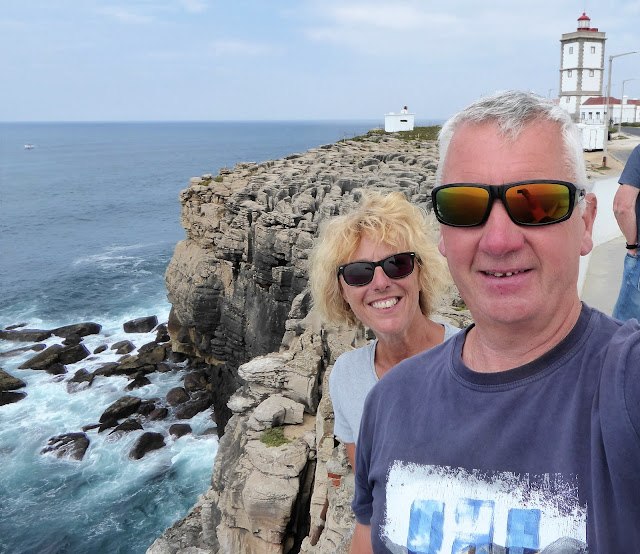Leaving
Mafra we continued along the minor roads of Portugal towards Peniche (N9-2,
N8-2, N247) or the ‘roads less travelled’ as we now like to refer to them, through
pretty countryside and then along the coastal road. Shortly after leaving Mafra, we stumbled
across this little windmill in a field.
Apparently, there are 7 similar ones in the area, built in the second
half of the 17th century.
 |
| 17th century windmill, near Mafra |
Before
getting to Peniche, we stocked up with food at the Intermarché, filled up with
fuel, did a big wash and dry and serviced Sonny (the motorhome) at the free
services provided by the supermarket – thank you Intermarché Portugal. We love these ‘one stop does all’ Intermarché
supermarkets and have used them a few times in Portugal now.
Peniche
sits at the end of a peninsula, enclosed by ramparts and is mainland Portugal’s
westernmost point and major fishing port.
It is a popular beach destination, and very popular with surfers. The town was once an island but the area has
silted up and is now joined to the mainland by a narrow strip. A couple of kilometres passed the town is
the tip of Cabo Carvoeiro, as far west as you can go. We parked up at the edge of the rugged peninsula,
next to the lighthouse (N39.36000 W9.40827) - wow, what a view!
 |
| Home is where you park it! |
We had a great view across to the Ilha da Berlenga. The only people allowed to live on the
small island are handful of fishermen who act as guardians, as it has been
declared a nature reserve with its colony of puffins and various other sea birds.
You
can arrange for a boat to take you across (about 10kms) but the sea looked
pretty choppy and we didn’t fancy it! This area was a shipwreck blackspot and a
lighthouse has been here since 1790. It continues
to be in used - its beacon was going in the evening when we were there.
There
is something majestic about this place, with its 25-metre high cliffs that have
strange karst formations on the top.
 |
| You can walk down quite a way to the sea and around the rocks – no safety barriers just a warning that you could get wet! |
 |
| The Atlantic ocean smashes against the rocky shore. |
Setting
off from Cabo Carvoeiro, we passed some more amazing rock formations on the
peninsula. Here, there were some wooden bridges to help you get across to the end.
 |
| It was quite overgrown in places, and apparently a natural habitat for some snakes! |
 |
| Looking across to Peniche and Cabo Carvoeiro on the far right |
Okay, I won't bore you with any more rocks, although they were stunning and the photos don't do them justice!
Leaving Peniche we headed to Obidos and parked up on an Aire that sits next to the 16th century aqueduct, that used to transport water to Obidos. (N39.35622
W9.15661). It has all the facilities and an honesty box asking that you pay €2 if
you use them and €6 if you stop overnight.
 |
| The aqueduct (fully intact), with the Aire just the other side of the road right of the car park |
Obidos
is an enchanting little village totally fortified by walls built in the 13th
and 14th century, with its
cobbled streets and alleyways and whitewashed houses tinged with blue.
Porta
da Vila is the
main gate into Obidos and contains a beautiful tiled chapel. The blue and white 18th century glazed tiles, called Azulejo,
depict the passion of Christ while the ceiling represents the crown of thorns.
 |
| Porta da Vila |
 |
| Bit of Street Theatre as you enter Obidos |
 |
| The main street where every shop is a souvenir shop or one selling the local drink - Ginja de Obidos, a sweet cherry liquor produced in the region. |
 |
| Walking up to get onto the ramparts |
 |
| Walking along the walls, a hair-raising walkway with no handrails and sheer drops in places – a nightmare for me with my fear of heights, but the views are stunning! |
 |
| The sheer drops of the walls - no health and safety in this country! |
 |
| The steep cobbled alleyways |
 |
| You know that you are in a touristy place when it costs €7.50 for a pint and a glass of fresh orange – ouch! |
We
move on from here tomorrow, further north to Tomar. Unfortunately, the forecast for the next few
days isn’t looking good for us. We have enjoyed some hot weather since coming into Portugal so we can't complain and a bit of rain to cool us down is no bad thing - well just for one day anyway!
Sally
x































































